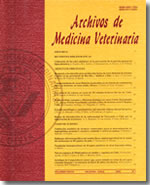Analytical sensitivity of staining and molecular techniques for the detection of Cryptosporidium spp. oocysts isolated from bovines in water samples: a preliminary study
Main Article Content
Abstract
Cryptosporidium spp. is a globally distributed protozoan that causes digestive disease in different animals including humans. Excreted oocysts contaminate water and soil, constituting a public health threat. Sensitive and fast methods to detect oocysts in water samples are necessary due to the small number of oocysts present in the environment and their low infectious dose. This study compared the analytical sensitivity of two staining techniques, modified Ziehl-Neelsen and Auramine versus a nested PCR that amplifies a region of ~520bp from 18S rDNA gene, to detect Cryptosporidium spp. in water samples. Water was inoculated with oocysts using serial dilutions, and then a water filtration method was used to recover the parasite oocysts. The staining techniques had similar analytical sensitivity, detecting 8 oocysts/mL, while the nested PCR detected down to 6 oocysts/mL. In conclusion, all of these methods are effective for Cryptosporidium spp. detection in water samples, contributing to the implementation of standardized diagnostic methods for environmental water infectious agents.

